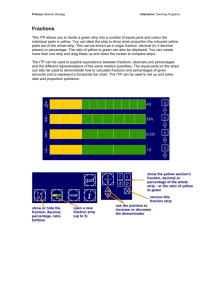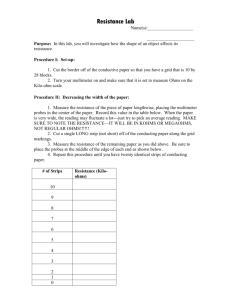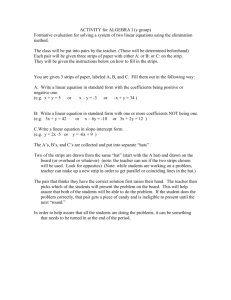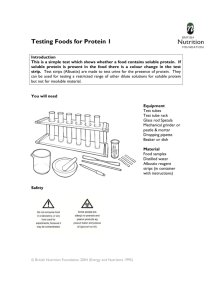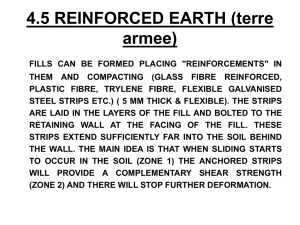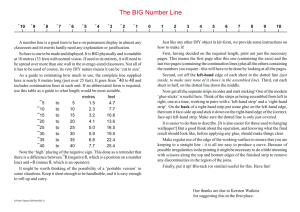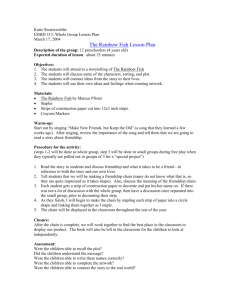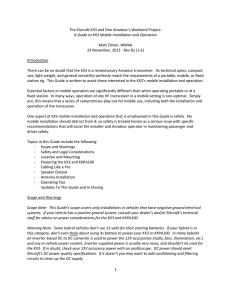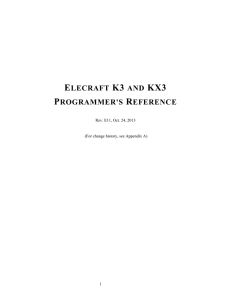Work as the Area Under a Graph of Force vs. Displacement
advertisement
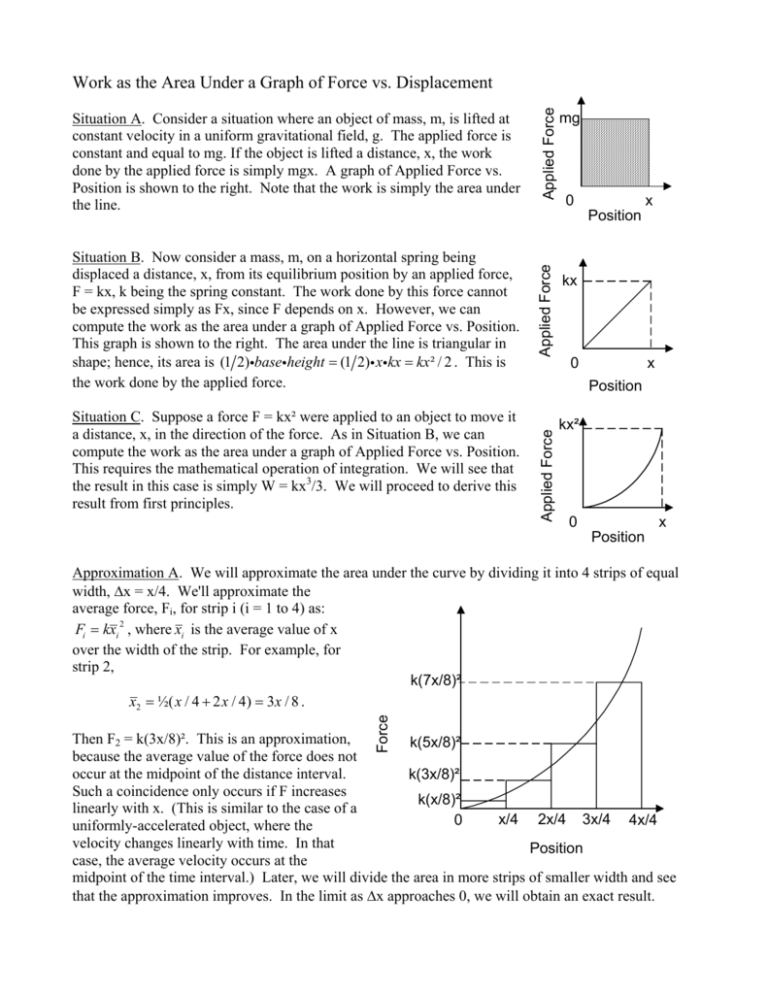
Situation C. Suppose a force F = kx² were applied to an object to move it a distance, x, in the direction of the force. As in Situation B, we can compute the work as the area under a graph of Applied Force vs. Position. This requires the mathematical operation of integration. We will see that the result in this case is simply W = kx3/3. We will proceed to derive this result from first principles. Applied Force Situation B. Now consider a mass, m, on a horizontal spring being displaced a distance, x, from its equilibrium position by an applied force, F = kx, k being the spring constant. The work done by this force cannot be expressed simply as Fx, since F depends on x. However, we can compute the work as the area under a graph of Applied Force vs. Position. This graph is shown to the right. The area under the line is triangular in shape; hence, its area is (1 2)ibaseiheight = (1 2)i xi kx = kx ² / 2 . This is the work done by the applied force. mg 0 Position x kx 0 x Position Applied Force Situation A. Consider a situation where an object of mass, m, is lifted at constant velocity in a uniform gravitational field, g. The applied force is constant and equal to mg. If the object is lifted a distance, x, the work done by the applied force is simply mgx. A graph of Applied Force vs. Position is shown to the right. Note that the work is simply the area under the line. Applied Force Work as the Area Under a Graph of Force vs. Displacement kx² 0 Position x Force Approximation A. We will approximate the area under the curve by dividing it into 4 strips of equal width, ∆x = x/4. We'll approximate the average force, Fi, for strip i (i = 1 to 4) as: 2 Fi = kxi , where xi is the average value of x over the width of the strip. For example, for strip 2, k(7x/8)² x2 = ½( x / 4 + 2 x / 4) = 3x / 8 . Then F2 = k(3x/8)². This is an approximation, k(5x/8)² because the average value of the force does not occur at the midpoint of the distance interval. k(3x/8)² Such a coincidence only occurs if F increases k(x/8)² linearly with x. (This is similar to the case of a x/4 2x/4 3x/4 4x/4 0 uniformly-accelerated object, where the velocity changes linearly with time. In that Position case, the average velocity occurs at the midpoint of the time interval.) Later, we will divide the area in more strips of smaller width and see that the approximation improves. In the limit as ∆x approaches 0, we will obtain an exact result. For now, we can see that the approximation shouldn't be too bad. Notice that the area of the approximately triangular piece included in each rectangular strip is nearly cancelled by another triangular piece that isn't included. Let's form a table now of the areas of the strips and then compute the sum. i xi 1 2 3 4 x/8 3x/8 5x/8 7x/8 Wi = Fi ∆x 2 Fi = kxi k(x/8)² k(3x/8)² k(5x/8)² K7(x/8)² k(x/8)²(x/4) k(3x/8)²(x/4) k(5x/8)²(x/4) k(7x/8)²(x/4) We've elected not to reduce the expressions for Fi and Wi in order to make a pattern apparent. We see that the total work, WI, in this approximation is: F xI F xI = ∑ W = k G J G J (1 + 3 + 5 + 7 ) H 8K H 4K 2 4 WA 2 2 2 2 i i =1 = 84 3 kx 256 = 0.328125kx 3 Force Approximation B. In order to improve the approximation, let's divide the area under the curve into 8 strips. Label the graph below with values of F and x, similar to the method of labeling in the preceding graph. The first strip is done for you. k(x/16)² 0 x x/8 Position Tabulate the results below. i xi 1 2 3 4 5 6 7 8 x/16 2 Fi = kxi k(x/16)² Wi = Fi ∆x k(x/16)²(x/8) 8 Now write the formula for the total work, WB = ∑ Wi , in such a way as to show a pattern in the sum. i =1 Finally, compute the coefficient of kx3 in decimal form to 3 or more places. Approximation C. We hope you see a pattern that will allow you to subdivide each strip by half again and quickly calculate the area. Do so without constructing a graph or a table. We think you'll find the following formula useful. (This is the formula for the sum of the squares of the first n odd integers. n ∑ (2i − 1) 2 = i =1 n(4n 2 − 1) 3 WC = ___________kx3 Approximation N. Now you should be able to write a general formula for any number, n, of strips. Note the width of each strip will be x/n. How will you express xi in terms of i and n? Finally, write WN in simplest form in terms of k, x, and n. Exact Value for the Work. In order to get the exact value for the work, you simply have to shrink the strip width to 0. This is the same as letting the number of strips go to infinity. Compute the following limit: W = lim WN n →∞ You should get exactly W = kx3/3. Note that the values you obtained for WA, WB, and WC do get closer and closer to 1/3. At least, they should if your calculations are correct. There's a shorthand notation for calculating the work. We replace the limit and summation notation with an integral operator, z xf xi f ( x )dx . What this says is to find the area under a graph of f(x) vs. x from an initial value of x, xi, to a final value, xf. Another way to say this is to find the integral of f(x) from xi to xf. For the special case of the given force law, F = kx², and the limits xi = 0 and xf = x, we write: W= z x 0 Fdx = z x 0 kx 2 dx We now know that the result of this integration is kx3/3. Noting a Pattern. Let’s take another look at the results for work for situations A-C presented on the first page. These results are: Situation Applied Force Work done by Applied Force A mg (mg)x B kx kx²/2 C kx² kx3/3 Note the pattern in the formula for work. In each case, the work is a constant multiplied by xn+1/(n+1), where n represents the power of x in the applied force. This provides evidence for the following generalization: If the applied force, F = kxn, where k is a constant, then the work done to displace an object a distance, x, under the application of the force is W = kxn+1/(n+1). While we haven’t proven this result, the foregoing discussion supports the result. As it turns out, this formula is generally valid and can be obtained from using the power law for integration (see next section). An exception is the case n = -1 (see not below). Power Law for Integrals. Suppose that the force is given by F = kx3. The method of calculating the area under the force vs. position graph by dividing the area into strips is, in principle, the same. However, the pattern established in the previous section now provides a shorter method. First, we write the integral for the work. W= z We use the power law for integrals: or, if xi = 0, For our cubic force law, we then obtain: z 0 xf xi z x 0 x Fdx = x n dx = x n dx = W= z x 0 z x 0 kx 3dx d 1 n +1 n +1 x f − xi n +1 i x n +1 n +1 kx 3dx = kx 4 4 Note: You may have already noticed that for n = -1, the power law gives an undefined result. In this case, the result of the integration of x-1 is ln(x). A table of integrals of common functions is found in Appendix E of your text.

